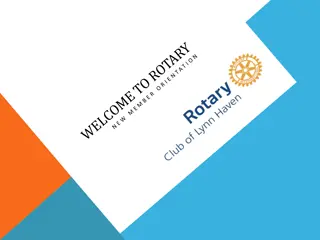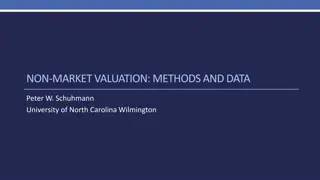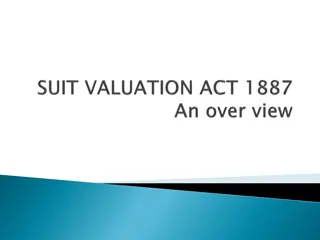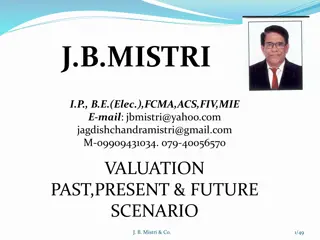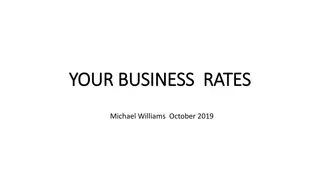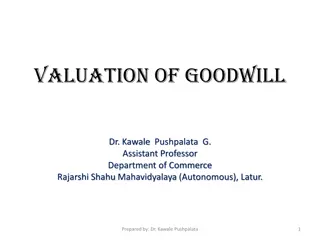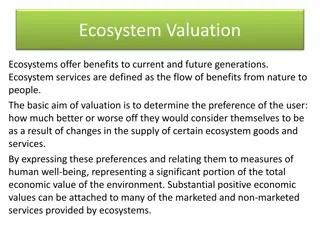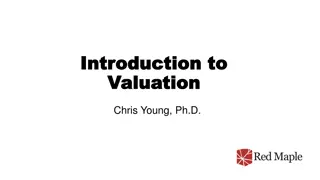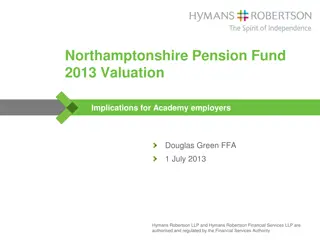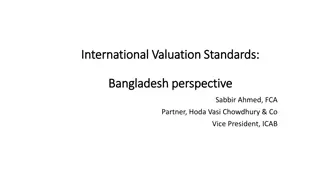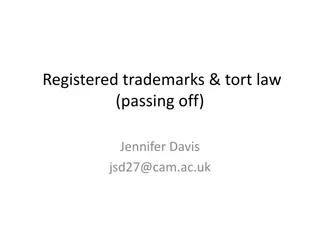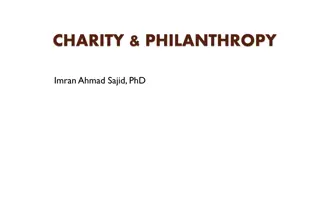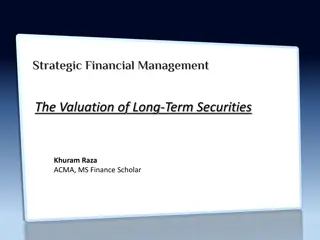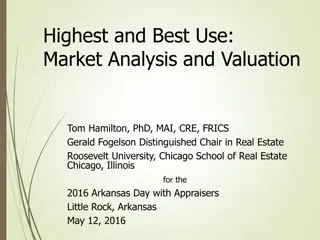Understanding the Valuation of Goodwill in Business
Goodwill in business refers to the intangible value derived from the reputation, customer connections, and other advantages of a company that contribute to higher profits. Valuation of goodwill is crucial when selling a business, admitting new partners, amalgamating firms, or determining share values. It involves assessing the potential future earnings exceeding normal returns on tangible assets. Goodwill is a valuable asset that requires accurate valuation for various financial and strategic decisions.
Download Presentation

Please find below an Image/Link to download the presentation.
The content on the website is provided AS IS for your information and personal use only. It may not be sold, licensed, or shared on other websites without obtaining consent from the author. Download presentation by click this link. If you encounter any issues during the download, it is possible that the publisher has removed the file from their server.
E N D
Presentation Transcript
Valuation of Goodwill
Introduction Goodwill is that element arising from the reputation, connection with customers, employees and outside parties and other advantages possessed by a business which enables it to earn greater profits than returns normally to be expected on the capital represented by employed in the business. It is thus the present value of a firm s anticipated super normal earnings. It is said to be an attractive force that brings in customers. Goodwill is the estimated value of the reputation of an enterprise. net tangible assets
Definition According to Kohler, Goodwill is the current value of expected future income in excess of a normal return on investment in net tangible assets. Institute of Chartered According Accountants of India Goodwill is an intangible asset arising from business connections or trade name or reputation of an enterprise. to
Features of Goodwill Goodwill can be sold with the entire business except on admission or retirement of a partner where new partner compensate the old partners or retiring partner gives up his rights in favour of remaining partners Goodwill is valuable only if it is capable of being transferred from one person to another. Goodwill represents a non physical value over and above the physical assets. Goodwill cannot have an exact cost as its value fluctuates from time to time due to internal or external factors which ultimately affect the fortune of the company. The value of goodwill is based on the subjective judgement of the valuer.
Need for Valuation of Goodwill Following are the circumstances when goodwill is valued and recorded: In case of sole trader, when the business is sold or a new person is admitted in the firm becomes a partnership firm, or the business is converted into a company for tax purposes. In case of partnership where there is change in the profit sharing ratio on admission, death and retirement of a partner or when two firms are amalgamated, or when the firm is sold to other person or firm or to a company In case of a joint stock company the need for valuation of goodwill arises in following circumstances: When the company is taken over by another company, e.g. in case of amalgamation or absorption. When the company s shares are not quoted on the stock exchange and their value is to be determined for the purposes of estate duty and wealth tax
CONTD. When a person wants to purchase a large block of shares with a view to acquire control over the management of company. When the business of the company is being taken over by the government When the management wants to write back goodwill which it wrote off earlier to reduce or eliminate the debit balance in the profit and loss account. Where a person or a company desires to purchase another business, the vendor will generally require an amount for goodwill and the purchaser will generally require his accountant to investigate the value so declared to be attached to the goodwill. Goodwill is to be brought into account upon consolidation of the assets and liabilities of a holding company and its subsidiaries.
Factors Affecting Value of Goodwill 1. Profitability: Profitability refers to the profit which the firm is expected to earn in future . The buyer of goodwill when paying for goodwill looks to the future profits which he expects to earn and not the profits earned in past. However, if past good profitability was due to nature of business, favourable location, ownership of patents and trademarks, access to supplies, stable political conditions, exceptionally favourable contracts or good management (which is likely to continue) the buyer will be prepared to pay a good amount for goodwill. 2. Capital Employed: The value of goodwill depends on the capital employed in the business to earn the average maintainable profits. it represents the equity shareholder s funds in the company.
CONTD. While calculating equity shareholder s funds any profit or loss on revaluation of assets should also be taken into account. Non trading assets, fictitious assets and goodwill appearing in balance sheet should be excluded. 3.Goodwill can be said to have value only when it can be transferred for valuable considerations. 4. A prospective buyer of business will be very much concerned with the possible future taxation liability. Buyer of goodwill expects to recoup what he has paid for goodwill out of future profits. The future profits are likely to be reduced by taxation and the buyer will not be ready to pay any large amount for goodwill.
Methods of Valuation of Goodwill 1. Simple Profit Method: In this method, goodwill is valued on the basis of a certain number of years purchase of the average profits of the past few years.Average may be simple or weighted. The value of goodwill is calculated by multiplying The adjusted annual profits by the number of years of purchase. For calculating Adjusted future profit or Maintainable profits: All expenses and losses not likely to incur in future as extraordinary salary of a person , abnormal losses are added to profits. All profits likely to come in the future as profit due to new line of business are added to profits. All expenses and losses expected to occur in future as salary of directors, depreciation in future, cost of management are deducted from profits. Profit not likely to recur are deducted from profits.
Calculation of Adjusted average profit: Simple average profit method is applied when there is fluctuation in profits and can be calculated by using following formula: Adjusted Average Profits = Total Adjusted Profits for all the given years Number of Years Weighted Average Profit Method is used when either weights for each year are given or when the profits are following an increasing or decreasing trend. Weighted Adjusted Average Profit = Total Product / Total Weights Value of Goodwill = Adjusted Average Profit Number of Years of Purchase
Example: P ltd. proposed to purchase the business of Shri Chintoo. Goodwill for this purpose is agreed to be valued at three year s purchase of i) simple average profits and ii) weighted average profits of the past four years. The appropriate weights to be used are: 2010 1, 2011 2, 2012- 3, 2013 4. The profits for these years are: 2010: Rs.1,01,000; 2011: Rs.1,24,000; 2012: Rs. 1,00,000 and 2013: Rs. 1,50,000. a) On 1st September, 2012 a major repair was made in respect of plant incurring Rs. 30000 which was charged to revenue. The said sum is agreed to be capitalised subject to adjustment of depreciation of 10 % p.a. on reducing balance method. b) The closing stock for year 2011 was over- valued by Rs.12000. c) To cover management cost an annual charge of Rs. 24000 is to be made. Solution: Calculation of Adjusted Profits:
2010 1,01,000 _ 2011 1,24,000 _ 2012 1,00,000 30,000 2013 1,50,000 _ Profit Add: Repair charged to revenue 1,01,000 _ 1,24,000 _ 1,30,000 1,000 1,50,000 2,900 Less: Depreciation 1,01,000 _ 1,24,000 12,000 1,29,000 _ 1,47,100 _ Less: overvaluation of closing stock in 2011 1,01,000 _ 1,12,000 _ 1,29,000 12,000 1,47,100 _ Add: Overvaluation of opening stock in 2012 1,01,000 24,000 1,12,000 24,000 1,41,000 24,000 1,47,100 24,000 Less: Management cost Adjusted (Future) Profit 77,000 88,000 1,17,000 1,23,100
i) Simple Average Profit Method: Rs. Total of Adjusted Profits 4,05,100 (Rs.77,000 +Rs. 88,000 +Rs. 1,17,000 +Rs. 1,23,100) Average Profit (Rs.405100 4) Value of Goodwill (Rs.101275 3) ii) Calculation of Weighted Average Profits Year Profit (Rs.) Weight Product (Rs.) 2010 77,000 1 77,000 2011 88,000 2 1,76,000 2012 1,17,000 3 3,51,000 2013 1,23,100 4 4,92,400 1,01,275 3,03,825 10,96,400 Average profit = 10,96,400 10 = 1,09,640 Goodwill at 3 years purchase = 1,09,640 3 = 3,28,920
2. Capitalisation of Profit Method: Following are the main steps for computing goodwill by this method: a) Ascertain the average net profit which it is expected will be earned in future; b) Capitalise this net profit at the rate which is considered a suitable return on capital invested in a business of the type under consideration. c) Find the value of the net tangible assets used in the business, i.e. assets less outside liabilities; d) Deduct the net tangible assets as per (c) from the capitalised profit obtained in (d) and the difference is Goodwill. Therefore, Goodwill = Capitalised Value of the business - Actual Capital Employed
While making an estimate of future maintainable profit on the basis of past profits, the following points need consideration: i) All unusual working expenses should be excluded. Interest on debentures and depreciation on fixed assets should be excluded. ii) Non trading assets should be excluded from capital employed and income derived from such assets should also be excluded from profit. iii) All necessary provisions for liabilities should be made but appropriation of profits shall not be taken into account. iv) Preference dividend shall be deducted. v) While calculating average profits, profits for the past years during which conditions have remained normal should be considered. vi) In case the profits for the past years used for calculating average profit, show a marked rising trend, it will be more appropriate to give more weightage to the profits of the later years as compared to former years. However, if the profits are showing a constantly falling trend, it will be appropriate to estimate the future profits on the basis of trend .
Example: Balance Sheet of P. Co. Ltd. As on 31stDecember, 2012 Liabilities Amount Assets Amount Paid up Capital Surplus Account Bank Overdraft Sundry Creditors Provision for Taxation 2,50,000 56,650 58,350 90,500 19,500 Goodwill Land and Building at cost Plant and Machinery at cost less Depreciation Stock at cost Book Debts less Provision for Doubtful Debts 25,000 1,10,000 1,00,000 1,50,000 90,000 4,75,000 4,75,000 Additional information: The company commenced operations in 2008. The profits earned before providing for taxation have been as: 2008:Rs.61,000,2009:Rs.64,000,2010:Rs.71,500,2011:Rs.78,000,2012: Rs. 85,000 You may assume that income tax at the rate of 50% have been payable on these profits. The average dividend paid by company for four years is 10% which is taken as reasonable return expected on the capital invested in business.
Solution: Profit for 5 years (61,000+ 64,000+ 71,500+ 78,000+ 85,000) = Less: 50% income tax 3,59,500 1,79,750 1,79,750 35,950 3,59,500 Average Profit (189750 5) Future Profits Capitalised at 10% = 35,950 100 / 10 = TotalAssets Less: Goodwill Less: Liabilities (58,350+ 90,500+ 19,500) 4,75,000 25,000 1,68,350 1,93,350 2,81,650 Net TangibleAssets Capitalised Profits Less: Net TangibleAssets Goodwill 3,59,500 2,81,650 77,850
3. Super Profit Method: In case of this method, goodwill is based on the average annual super earned by the business. The term super profit means the profit over and above the normal profit. For computation of super profits, the following three factors are required: i) Normal rate of return: This is the rate of return which an investor expects on his investment. It may be aggregate of pure rate of return and risk rate of return. ii) Capital employed: It may be calculated on the basis of asset side items and liabilities side items. Proceeding from asset side: Capital employed: Fixed assets + Trade investments + Current assets Debentures Current liabilities
Proceeding from liabilities side: Capital employed: Paid up Equity and Preference Share Capital+ Accumulated Balance in Capital Reserves, General Reserves and Credit Balance in Profit and Loss account Revaluation Profits(or Loss) Fictitious assets - Non trading assets Average capital employed: = Capital Employed at the end of the year of CurrentYear s Profit after Tax Or = Capital Employed at the beginning of the year- of Current Year s Profit after Tax iii) Normal profit: It is calculated by multiplying the normal rate of return with capital employed or average capital employed. Goodwill can be calculated by any of following methods: i) Purchase of super profit method: Super profits are those profits remaining after deducting the estimated annual future profit :
a) Areasonable remuneration of proprietors and management b)An amount considered to be a reasonable return on the amount of capital invested in the tangible assets Allowance should be made for expenses charged against past profits which are not likely to recur and also for expenses which are likely to recur in future. There must be deducted an amount which is calculated to be a reasonable return on the capital invested in tangible assets. This percentage is then applied to capital invested and the resulting figure deducted from already adjusted average profit, the final result giving the average annual super profit. Under this method, goodwill is ascertained as follows: Goodwill =AverageAnnual Super Profit Number of Years
Example : Balance sheet of Vishnu Ltd. As on 31 -03-2013 Liabilities Amount Assets Amount Equity Share Capital Capital Reserve Surplus Account Creditors Depreciation Fund Land and Building Machinery 1,50,000 30,000 13,000 63,000 Goodwill Land and Building Machinery Stock Debtors 49,000 Less: Provision for Doubtful Debts 1,500 Cash and Bank Balances 15,000 95,000 60,000 57,500 7,500 15,000 47,500 3,500 2,78,500 2,78,500 The company s business is to be purchased by Shiv Ltd. Calculate the value of goodwill using following information: 1. The reasonable rate of return on capital employed in the class of business done by the company is 12%. 2. The company s average profits for the last five years after making 50% provision for taxation amounted to 47,500.
3. The present market value of land and building is 1,10,000. 4. The assets are to be taken at their book values. 5. The directors of Vishnu ltd. (two in number) are to be appointed on Board of Directors of Shiv ltd. The worth of their services is 5,000 p.a. for each of the directors but no charge has been made regarding this against the profits of Vishnu ltd. The goodwill of business of Vishnu ltd. is to be taken at four years purchase of super profits of the company. Solution: Calculation of Capital employed: Land and Building Machinery Stock Debtors less Provision for Doubtful Debts Cash and Bank Balances 1,10,000 60,000 57,500 47,500 3,500 2,78,500
Less: Creditors Depreciation Fund 63,000 22,500 85,500 1,93,000 Capital Employed Calculation of Super Profit: Average profits of last five years after tax Average profit before 50% tax(47,500 100/50) Less: Director s Remuneration (2 5,000) Average Profits (in future) Less: 50% Tax Average profits (after tax in future) Less: Reasonable Return on Capital Employed 12% on 193000 Super Profits Calculation of Goodwill: Goodwill at 4 years purchase of super profits = (19,340 4) = Rs. 77,360 47,500 95,000 10,000 85,000 42,500 42,500 23,160 19,340
ii) Sliding Scale Valuation of Super Profit: This method is a slight variation of the purchase of super profit method. It has been advocated by A.E. Cut forth. The method is based on the theory that the greater the amount of super profit, the more difficult it would be to maintain it. The super profit, in this case is divided into two or three divisions. Each of these divisions is multiplied by a different number of years purchase in descending order from first division. For example, if the amount of super profit is estimated at Rs. 6,000, the value of goodwill will be calculated as under: First Rs. 2000 at (say) 3 years purchase Second Rs. 2000 at (say) 2 years purchase Third Rs. 2000 at (say) 1 years purchase Total Value of Goodwill 6,000 4,000 2,000 Rs.12,000
iii) Annuity Method of Super Profit: This method is based on the logic that the purchaser should pay now for goodwill only the present value of super profits calculated at a proper rate of interest. Thus, goodwill is the discounted value of the total amount calculated as per purchase of super profit method. Value of goodwill =AverageAnnual Super profit Annuity rate Example : Balance sheet of Taj Ltd. As on 31stDecember, 2006 Liabilities Share capital (in shares of Rs. 100 each) 1500 6% Preference shares 6500 Equity Shares Profit and account 5% Debentures Sundry creditors Amount Assets Goodwill Freehold property Plant and machinery less depreciation Stock Debtors net Bank balance Amount 50,000 3,75,000 3,50,000 1,50,000 6,50,000 4,50,000 3,00,000 2,39,350 3,70,000 3,99,250 2,45,000 Loss 17,89,250 17,89,250
Profit after tax for the three years 2004, 2005 and 2006, after charging debentures interest were Rs. 220500, Rs. 322500 and Rs. 240000 respectively. i) The normal rate of return is 10% on the net assets attributed. ii) Goodwill may be calculated at 3 times adjusted average super profits of the 3 years referred to above (present value of Re.1 is 2.487) iii) The value of freehold property is to be ascertained on the basis of 8 % return. The current rental value is Rs. 50400 iv) Rate of tax applicable is 50% v) 10% of profits for 2005 referred to above arose from a transaction of a non- recurring nature. vi) Aprovision of Rs. 15750 on sundry debtors was made in 2006 which is no longer required; profit for the year 2006 is to be adjusted for this item. vii) A claim of Rs. 8250 against the company is to be provided and adjusted against profit for 2006. Ascertain the value of goodwill of the company.
Solution: 1. Computation of Capital Employed: Net asset of the company Freehold property at market value ((50400 100) 8 ) Plant and Machinery Stock Debtors Add: Provision no more necessary Bank balance Rs. Amount (Rs.) 6,30,000 3,50,000 3,70,000 3,99,250 15,750 4,15,000 2,45,000 20,10,000 Less: Liabilities 5 % Debentures Sundry creditors Outstanding claim Capital employed as on 31.12.2006 3,00,000 2,39,250 8,250 5,47,500 14,62,500
2. Computation of future maintainable profits: Profits for: 2004 2005 Less: Non- recurring profit 10% 2006 Add: Provision of sundry debtors no more necessary Rs. Amount (Rs.) 2,20,500 3,22,500 32,250 2,40,000 15,750 2,90,250 2,55,750 8,250 2,47,500 3,750 Less: Claim omitted Less: 50% tax on (Rs.15,750 8,250) = 50 % of Rs. 7500 2,43,750 7,54,500 Average Profit = Rs. 754500 3years = Rs. 2,51,500
3. Calculation of Super Profit: Future maintainable profit (average profit as above) Rs. 2,51,500 Less:Normalprofit10%oncapitalemployed Super Profit Valuation of Goodwill: Present value of Re.1 per annum for three years @ 10% annum (2.487) Goodwill = 1,05,250 2.487 = 2,62,000 Rs. 1,46,250 1,05,250 iv) Capitalisation of Super Profit Method: Under this method, the value of goodwill is calculated by calculated by capitalising the super profit at the normal rate of return. This method attempts to determine the amount of capital needed for earning super profit. Value of Goodwill = Average annual super profit 100/Normal rate of return
Example: Shri Rajesh has invested a sum of Rs. 6,00,000 in his own business which is very profitable one. The annual profit earned from his own business is Rs. 1,20,000 which included a sum of Rs. 20,000 received as compensation for acquisition of part of his business premises. The money could have been invested in deposits for a period of five years at 10% interest and he could have earned Rs.14,400 p.a. in alternative employment. considering 2 % as fair compensation for the risk involved in the business calculate the value of goodwill of his business on capitalisation of super profits at a normal rate of return of 12%. Solution: Calculation ofAdjustedAverage Profit: Profit from business Less: Compensation for premises Notional salary of Shri Rajesh Rs. 1,20,000 Rs. Rs. 20,000 14,400 Rs. 34,400 85,600
Calculation of Normal profit: Normal profit = Capital employed Normal rate of return = 6,00,000 12/100 = 72,000 Calculation of Super profit: Adjusted average profit Normal profit 85,600 72,000 = 13,600 Goodwill = Super profits 100 / Normal rate of return 13,600 100 / 12 = 13,333
Reference: JR Monga, Corporate Accounting www.icai.org




